This was published 11 months ago
Eloquent and beguiling: Operatic Hamlet is a triumph
By Millie Muroi, Cassie Tongue, Shamim Razavi, Harriet Cunningham and John Shand
OPERA
Hamlet
★★★★★
Sydney Opera House, July 20
Until August 9
Reviewed by Harriet Cunningham
After a triumphant debut at the Glyndebourne Opera Festival in England and seasons at the Adelaide Festival, New York’s Metropolitan Opera and the Munich Opera Festival, Brett Dean’s Hamlet has finally made it to Sydney.
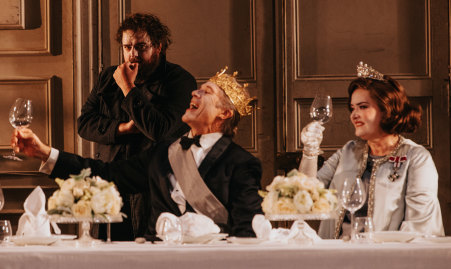
The ensemble is unequivocally outstanding in Brett Dean’s Hamlet at Sydney Opera House.Credit: James Brickwood
For four centuries, Hamlet has been staged, translated, reimagined and bowdlerised. In this incarnation, librettist Matthew Jocelyn mines the text to create a new quintessence of Shakespeare’s play. Acknowledging that there is barely a line in Hamlet which has not found a life of its own beyond the original drama, he abandons the poetry in favour of a magpie-like search for flashes and glints.
Hamlet’s infamous soliloquy is flagged by “or not …” ; “the rest is …” is left unfinished; and just one word from his letter to Ophelia becomes a heartbreaking refrain of “Never, never”. These touchstones then become the leitmotifs of Dean’s music, at once reassuring and tantalising, patterns to grab in a dizzyingly complex score, but also invitations, like a door cracked open, with the promise of more beyond.
Director Neil Armfield’s 2017 production is as eloquent as ever, with modish costumes by Alice Babidge, and lighting (designed by Jon Clark and realised by Peter Harrison) playing a crucial role in the storytelling. As for Ralph Myers’ handsome set, it has undergone surgery to fit into the Joan Sutherland Theatre, most radically in the burial scene.
In the original, the gravedigger appears from an open grave let into the floor of the stage, and it feels like we’ve entered another dimension, literally and metaphorically. Now Hamlet, Laertes and the Gravedigger have to settle for a black shroud. But it is still a delight when the opulently panelled walls and doorways swivel, magically, to reveal the grubby underside of the Danish court.
Dean’s music also feels like it has been shoehorned into the Opera House pit, although there is a sense that some of the crowd scene music, in particular Claudius and Gertrude’s marriage feast, would overwhelm wherever it played. His music is most beguiling when he zooms in to let us hear his exploding palette of unexpected noises, spooky hums and his approach to vocal writing, which acknowledges but is not defined or confined by operatic singing.
Conductor Tim Anderson is the linchpin, landing sounds arriving from every direction like a sonic air traffic controller.
The ensemble is unequivocally outstanding. Many of the singers have been with the production for a long time, including Rod Gilfry, a riveting Claudius, ferocious accordionist James Crabb, and Christopher Lowrey as a tittering Guildenstern. Others are new, including exciting young tenor Nicholas Jones as Laertes, a pitch-perfect Kanen Breen as Polonius and Catherine Carby, who gives a moving portrayal as Gertrude (stepping in to replace the late Jacqueline Dark, to whom this season is dedicated).
Then there is Lorina Gore, who has grown into the extraordinary creation that is Dean’s Ophelia, and magnificent Allan Clayton, who has been there from the start, as Hamlet. No more words, just go and see them.
THEATRE
COST OF LIVING
★★★½
Wharf 1 Theatre, July 19
Until August 18
Reviewed by JOHN SHAND
Our lives are many stranded, Martyna Majok’s play seems to tell us: so many lengths of rope, with infinite subtleties in our interdependence. Individual strands can snap or fray so easily when stressed – the wonder is that any of our relationships ever pass the test of time.
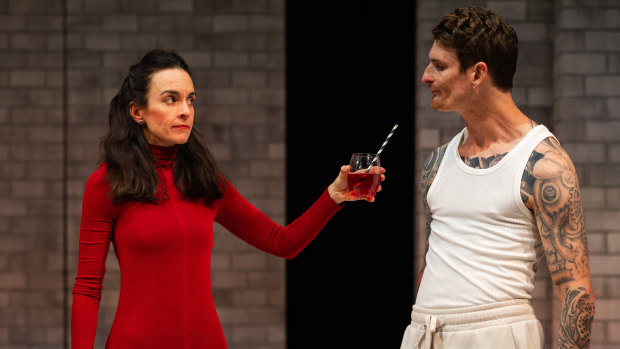
Jess and John surprise each other in Cost of Living.Credit: Morgan Roberts Photography
Cost of Living won Majok the 2018 Pulitzer Prize for Drama, and it will probably outlive most plays of our time. Majok puts those metaphorical ropes under perilous tension, and we sit spellbound, open-mouthed and teary, watching the strands that fray and those that hold. Most fray.
The play charts snippets of four lives: two duets that run in parallel until they converge into a kind of fugue by the end. By then, we’re cleansed and drained and reminded how best to be ourselves, not as individuals, but as humans: fully interactive and reactive creatures.
One duet is for John (Dan Daw) who has cerebral palsy and auditions Jess (Zoe de Plevitz) to be his new carer. Meanwhile, Eddie (Philip Quast) turns up unexpectedly as the fill-in carer for his ex-wife Ani (Kate Hood), who’s become a quadriplegic since their separation. Both duets are played out in the rough and tumble of New Jersey, a place they fill to overflowing with their assorted flawed attempts at being human.
As the text specifies, this first Australian production, co-directed by Daw and Priscilla Jackman for Sydney Theatre Company, casts disabled actors in the roles of John and Ani. A breakthrough for mainstage theatre here, it’s as far from a box-ticking exercise as the play is from being humourless.
John gives Jess the job, even though she usually works in late-night bars, and Ani lets Eddie help, despite her bitterness and his guilt. The fascination lies in the way the dynamics of the two relationships evolve. We come to see that Ani and Eddie’s marriage, which lasted for 20 years, was partly founded on their ability to make each other laugh. People who laugh together, after all, more readily forgive.
John is rich and Jess is as poor a stray cat. She keeps her life under wraps, and initially bristles at John’s questions because she knows that when she softens, she makes herself vulnerable. She, the carer, is more vulnerable than John, the cared for.
Majok writes the best dialogue since Edward Albee. Often it jolts between subjects; sometimes it stalls completely or accelerates wildly; sometimes the big stuff is left unsaid, and often characters talk over one another, not wanting to hear a word.
They lie to each other and themselves, and yet we can’t help but be moved by them in a way that makes most other plays seem like they’re merely skirting around life’s edges: not taking a big bite from the core.
The actors give us the very marrow from their bones, and to single one out from the quartet borders on perverse, but Kate Hood’s saw-tongued, suspicious, candid, funny, desperate Ani is a towering creation. Daw is droll, brave and moving in equal measure, de Plevitz so good at shedding and restoring Jess’s protective layers, and Quast makes Eddie a big bear of a person, looking for someone to hug to death.
Daw and Jackman’s production glows with all the play’s compassion and figurative face-slaps, but it’s not perfect. Michael Scott-Mitchell’s set, aesthetically as spartan as a public toilet, is too busy and too clever. The play’s in-built design complexities feel like they want simple solutions, so nothing overshadows the humanity.
VOLUME FESTIVAL
KIM GORDON
★★★½
The Tank, Art Gallery of New South Wales, July 18
Reviewed by Shamim Razavi
Volumes have been written about the Tank’s muddy acoustics and problematic sight lines, so it is a relief to witness a performance so edgy and intense it is hard to imagine it being hosted anywhere else.
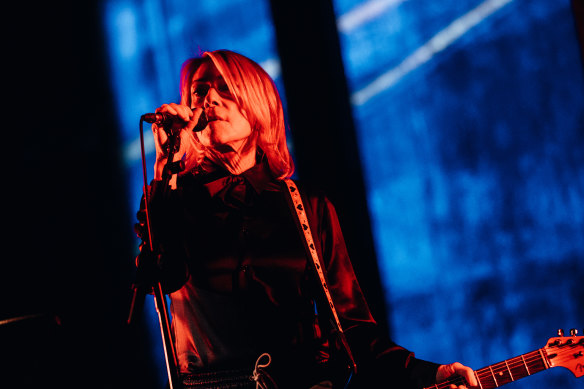
Tank girl: Kim Gordon at AGNSW’s Volume festival.Credit: Jordan Munns
Kim Gordon has lost none of the zest for experimentation and noise that characterised Sonic Youth, but where her former band hid a catchy melody in the mix, Gordon’s solo work leans into the discomfiting abstract aspects of their sound.
It’s not that it isn’t catchy; rather that the hooks are in booming rhythm backed by a monotone, spoken vocal. And so it doesn’t matter that the lyrics – seemingly a recitation of her luggage packing list – on opener Bye Bye are unintelligible on this night when its earworm beat is such a banger.
This formula applies for much of the set – a top-to-toe recount of her latest album The Collective, with some picks from 2019’s No Home Record for the encores – and, thrillingly, it is stronger and more vital with a live band.
For a sound so replete with distortion, the added overtones of the venue merely bring additional echo and fuzz: her closing moans on Tree House are amplified into ululations, the layered vocals on I Don’t Miss My Mind gain extra layers of reverb and the deep beats sound all the deeper with Madi Vogt’s machine-like drumming.
Likewise, quieter numbers such as Shelf Warmer are allowed to blossom from their minor album forms, resonating in the dark intensity between the barrage of noise that precedes and follows.
Volume gigs are never tightly packed, which allows the audience space to wander around and experience multiple perspectives. On this night that allowed a choice from a sweaty Greenwich Village basement happening at the front, through to an art-house installation at which to close your eyes and sway among the Tank’s columns at the back, with infinite variations between.
While Gordon does her best impersonation of effortless cool, it is clear that the experience artfully, deliberately is just accessible enough to reward the effort it demands of both performer and audience.
At last, a Volume show befitting of the setting.
Kim Gordon plays at the Tank again on Friday, July 19.
MUSIC
CONAN GRAY
★★★★
ICC Sydney, July 17
Reviewed by Millie Muroi
Conan Gray is hard to pinpoint but easy to love. The 25-year-old American singer-songwriter’s audience is mostly young but his look, sound and stage presence transcend time.
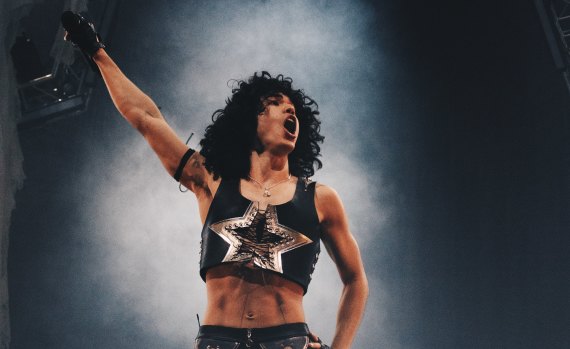
“I would like to report that I did meet a koala and now I have chlamydia”: Conan Gray.Credit: Ian Reyno
Clad in ’70s metallic-silver flare pants and a matching cropped top, Gray channelled the rock-star image and energy of that era, bringing back the spirit of frontmen like Freddie Mercury and making it his own.
The former YouTuber opened the show in Sydney with his trademark dark humour. “I would like to report that I did meet a koala and now I have chlamydia,” he declared before diving into Wish You Were Sober from his debut studio album.
Gray’s Found Heaven tour was mostly a no-frills show with simple projections and straightforward choreography. But Gray’s theatrical movements, his image and spontaneity kicked in at the right times to galvanise the performance.
Hits from latest album Found Heaven, including Lonely Dancers, Boys & Girls and Bourgeoisieses, which borrow from the upbeat, synth-pop sounds of the ’80s, were brought to life by Gray’s versatile tenor voice. His vocals were weaker towards the beginning of the set but it was only a short time before he was comfortably nailing high notes and vibratos.
While Gray had no trouble bringing the crowd to their feet, his real strength manifested in the slower, more vulnerable parts of the show, featuring slightly older songgs such as People Watching, The Story and Family Line. Gray’s tenderness, vocal control and storytelling between songs while cradling his guitar were enchanting.
“I’d never been afraid to die because I never thought I had much to live for,” he told his audience. “Then I opened up to the idea of falling in love and now I’m so scared to die.”
The well-paced set list ended with such heart-wrenchers as Memories from his second album Superache, and sleeper hit Heather. Lifting the energy during his encore and backed by his solid band, Gray belted out his recent Alley Rose: a ballad reminiscent of ’70s icon Elton John.
Like many young artists, Gray began by uploading covers and original songs to YouTube as a teenager – so it is perhaps unsurprising he seems to speak to the zeitgeist of today’s youth.
At the same time, he has harnessed the unique zeal and artistry of musical legends who came before him, injecting those attributes into his production, reinventing them and proving himself to be a timeless showman.
MUSICAL
Tick, Tick… BOOM!
★★★
Old Fitzroy Theatre, July 17
Reviewed by Cassie Tongue
Tick, Tick… BOOM! is the other musical by Jonathan Larson, a semi-autobiographical and onetime solo show (now remade for a cast of three) about a struggling composer named Jonathan staring down the barrel of his 30th birthday, wondering if it’s time to grow up and get a real job – even as he’s bursting with the need to write songs and tell stories.
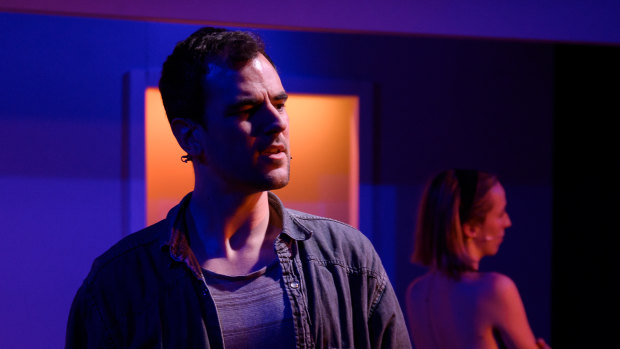
A scrappy, lively, late-night production: Brodie Masini and Tessa Olsson in Tick, Tick … BOOM!Credit: Robert Miniter
In hindsight, it’s about tantalising near-success and tragedy; in just six years, Rent would revolutionise Broadway, and Larson would die, suddenly and unexpectedly, before opening night. He could have probably never dreamed of that show’s success or that this early work would endure and become an excellent film in 2021, helmed by a later Broadway disruptor, Hamilton’s Lin-Manuel Miranda.
And it would be beyond imagination that, in 2024, in the basement of a Sydney pub, a collective of recent NIDA graduates would be staging a scrappy, lively, late-night production of Tick, Tick… BOOM!
Brodie Masini is Jonathan here and delivers a performance bursting with future promise: indefatigable, pleasantly exuberant. He’s flanked by Tessa Olsson as Susan (and others) and Hamish Wells as Michael (and others), and the trio ably summon a world of artists facing the decidedly un-glamorous question of whether it’s time to trade the arts for a steady income.
Shaggily directed by Kurtis Laing, the production is bursting with appealing new-creative zeal and a commitment to the show’s big questions about art, identity and making theatre. This doesn’t smooth out the rough edges of the performances, technical specifications or sound design, but it does mostly render those quirks, or still-developing skills, charming.
That’s partly thanks to raw, unfocused talent succeeding more than it fails, but it’s also partly by design. As a show, Tick, Tick… BOOM! has heart, gambolling DIY-like enthusiasm, and an allergy to slick perfectionism that helps emerging companies such as Laing’s Good Time Theatricals make something that works.
It’s best to keep it simple: you don’t need bells and whistles to tell this story. You just need a company determined to raise their voices and make a mark, and that’s what’s happening here at the Old Fitz.
See it if you love the musical magic that happens when a story morphs into a number like it might die if it can’t sing. See it if you love watching people love what they do, even if the end result is both moving and messy.